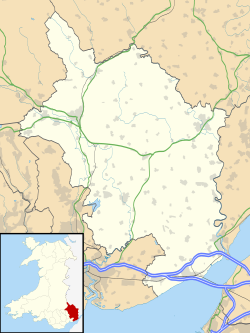Llanvihangel-Ystern-Llewern
| |
|---|---|
 | |
Location within Monmouthshire | |
| OS grid reference | SO432139 |
| Community | |
| Principal area | |
| Preserved county | |
| Country | Wales |
| Sovereign state | United Kingdom |
| Post town | MONMOUTH |
| Postcode district | NP25 |
| Dialling code | 01600 |
| Police | Gwent |
| Fire | South Wales |
| Ambulance | Welsh |
| UK Parliament | |
Llanvihangel-Ystern-Llewern (Welsh : Llanfihangel-Ystum-Llywern) is a village in the community of Whitecastle, in Monmouthshire, south east Wales. It is located between Abergavenny and Monmouth and north of Raglan. The River Trothy passes close by.
